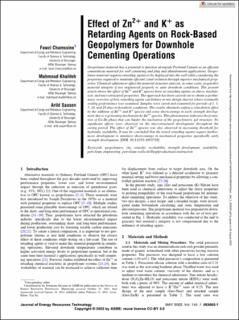| dc.contributor.author | Chamssine, Fawzi | |
| dc.contributor.author | Khalifeh, Mahmoud | |
| dc.contributor.author | Saasen, Arild | |
| dc.date.accessioned | 2023-03-16T13:18:10Z | |
| dc.date.available | 2023-03-16T13:18:10Z | |
| dc.date.created | 2022-07-25T22:26:40Z | |
| dc.date.issued | 2022 | |
| dc.identifier.citation | Chamssine, F., Khalifeh, M., & Saasen, A. (2022). Effect of Zn2+ and K+ as retarding agents on rock-based geopolymers for downhole cementing operations. Journal of Energy Resources Technology, 144(5), 053002. | en_US |
| dc.identifier.issn | 0195-0738 | |
| dc.identifier.uri | https://hdl.handle.net/11250/3058816 | |
| dc.description.abstract | Geopolymer material has a potential to function alongside Portland Cement as an efficient cementitious material for well cementing and plug and abandonment applications. Geopolymer material requires retarding agents to be displaced into the well while considering the properties required to maintain efficient zonal isolation through superior mechanical properties. Chemical admixtures affect the material structure and can, in some cases, jeopardize material integrity if not engineered properly to suite downhole conditions. The present article shows the effect of Zn2+ and K+ species have as retarding agents on slurry, mechanical, and microstructural properties. The approach has been carried out to obtain a preliminary overview of how retarding agents can behave in mix design slurries where eventually sealing performance was examined. Samples were cured and examined for periods of 1, 3, 7, 14, and 28 days at downhole conditions. The results obtained confirm a retardation effect by the addition of Zn2+ and K+ species and some shortcomings in early strength development due to a poisoning mechanism by Zn2+ species. This phenomenon indicates the formation of Ca-Zn phase that can hinder the nucleation of the geopolymeric gel structure. No significant effects were observed on the microstructural development throughout the curing period. The effect of Zn2+ species was also observed in increasing threshold for hydraulic sealability. It may be concluded that the tested retarding agents require furthermore development to minimize shortcomings in mechanical properties specifically early strength development. | en_US |
| dc.language.iso | eng | en_US |
| dc.publisher | American Society of Mechanical Engineers | en_US |
| dc.rights | Navngivelse 4.0 Internasjonal | * |
| dc.rights.uri | http://creativecommons.org/licenses/by/4.0/deed.no | * |
| dc.title | Effect of Zn2+ and K+ as Retarding Agents on Rock-Based Geopolymers for Downhole Cementing Operations | en_US |
| dc.type | Peer reviewed | en_US |
| dc.type | Journal article | en_US |
| dc.description.version | publishedVersion | en_US |
| dc.rights.holder | The authors | en_US |
| dc.subject.nsi | VDP::Teknologi: 500 | en_US |
| dc.source.journal | Journal of energy resources technology | en_US |
| dc.identifier.doi | 10.1115/1.4053710 | |
| dc.identifier.cristin | 2039493 | |
| cristin.ispublished | true | |
| cristin.fulltext | original | |
| cristin.qualitycode | 1 | |

